
Pugio_-_Gladius_brevis_est
.pdf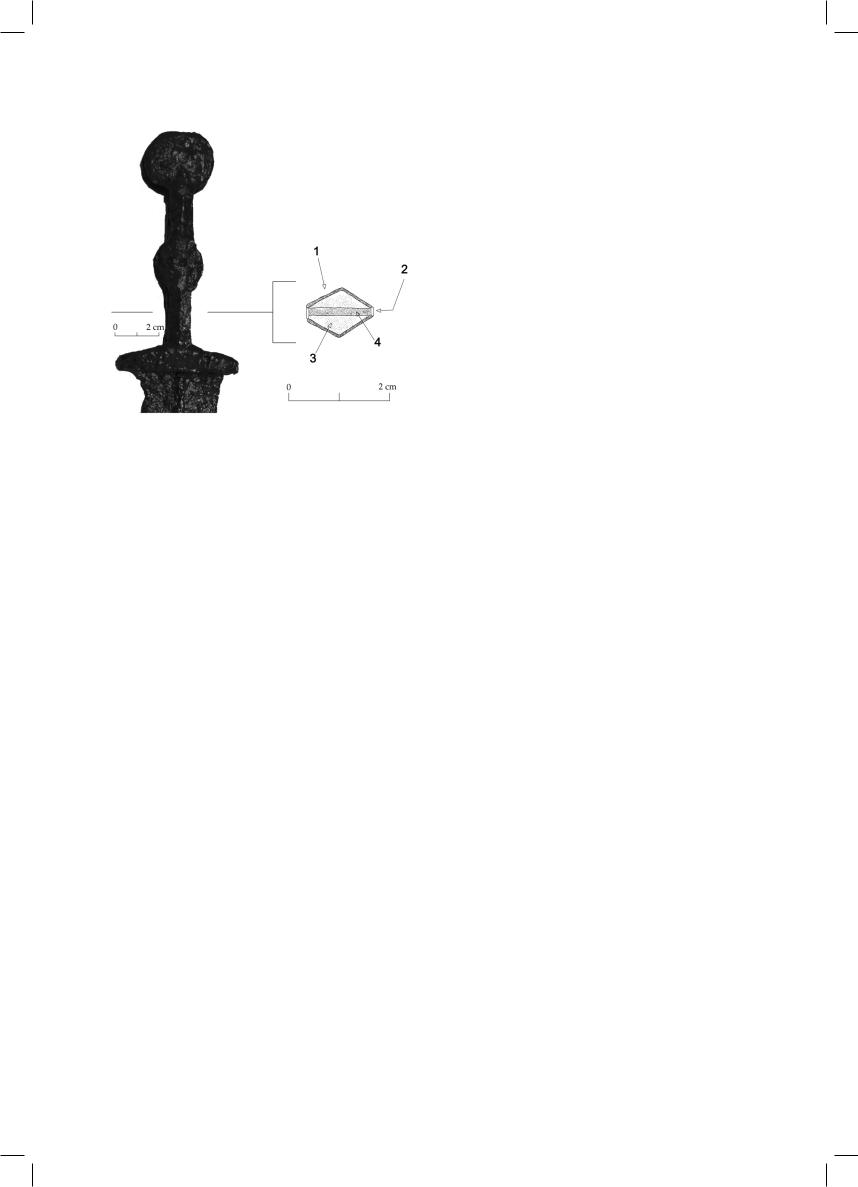
CHAPTER V - CONSTRUCTION TECHNOLOGY
Fig. V/10: on the left is an example of a pugio hilt including the |
|
most common features. It is a Republican exemplar on which we |
|
can see the guard with its overhanging edges; the grip cross section |
|
is vaguely diamond shaped with a clearly defined knob in the centre |
|
together with a rivet; and finally the upper pommel, also circular |
|
and with a central rivet. On the right, a cross section of the grip |
|
made by quite a common method and, therefore, to be considered a |
|
stereotype, in which we find: |
|
1) xternal metallic lamina; |
|
2) lateral, metallic finishing ribbon, with both a decorative and |
|
sealing function forthe grip at the point in which the laminas meet |
|
at point; |
|
3) material for filling the inside, which could have been wood or |
|
bone; |
(photo and drawing by the author). |
4) blade tang; |
|
The meeting point between the blade and the hilt is the tang. Always forged in a single piece together with the blade, it is made in two different types: one which is simpler and more solid, with a cross-section tending towardsarectangularshape,whichremindsusofasmaller version of the gladius, and which we will call the “rod” type. Then other is more complex and forged in a flat shape, which we will call the “flat” type. The latter type did not have a regular cross-section, but rather followed the shape of the profile of the grip. In the central part there wasacircularenlargement(fig.V/9),basicallyofthesame size as the one on the grip. This latter type also had holes which rivets passed through to attach the hilt.
The technical motivation which encouraged the tang to be forged in this, apparently more complicated, way, it not completely clear, but was most probably aimed at facilitating the attachment of the hilt and the sealing of the spaces inside. The sealing was often done in hard wood, but there are quite a few exemplars which show traces of it in bone.
The hilt: varied in size, about 10 cm long and had a depth of about 1.5-1.8 c.m. It was composed of three main elements: the hand guard (or guard), the grip and the superior pommel. In some cases these three elements were not separate but formed part of a single piece.
The hand guard was never accentuated and its overall size was always moderate. Its main function was to allow a solid point of attachment between the hilt and the blade, besides holding back the hand of whoever held the weapon.As seen in chapter I, often – but not always – two openings were made through it, which were also present on the blade below, through which rivets were affixed in order to obtain a solid attachment of the two elements: hilt
Fig. V/11: stylized blow-up drawing of the construction components of a hilt made by “composite” technology. (drawing by the author)
and blade. It generally passed over the edge of the upper profile of the blade by only a few millimetres, and in some case was practically a thin strip, even though there are not a few unusual exemplars (see exemplar no.30 Chap. IX), showingtheopposite.Consideringtheoverallsmallsizeof the weapon and its light weight in contrast with the gladi it was not necessary to create this construction element in order to facilitate the perfect positioning of the weapon in the hand, nor was it necessary to assign it the function of balancing the weight, which, due to the way it was conceived for the pugiones, it is not able to do. In contrast with all the other parts of the hilt, it had an altogether quite simple geometrical shape, something like a metal element in a parallelepiped shape, which varied only in the first two periods in the upper part, which was slightly inclined (Fig. I/7 chap. I).
The upper end pommel could be in a circular, semicircular or bi-lobed shape, depending, as we know, on the historical period. In the gladi it was an extremely importantcomponentbecauseitwasmeanttofacilitatethe brandishingoftheweaponbyleaningagainstthewristand thus creating a greater lever. However, with the pugiones this could not happen because its size is no where near
51
Libro inglese BAR [A4].indd |
51 |
27/05/2012, 16.23 |
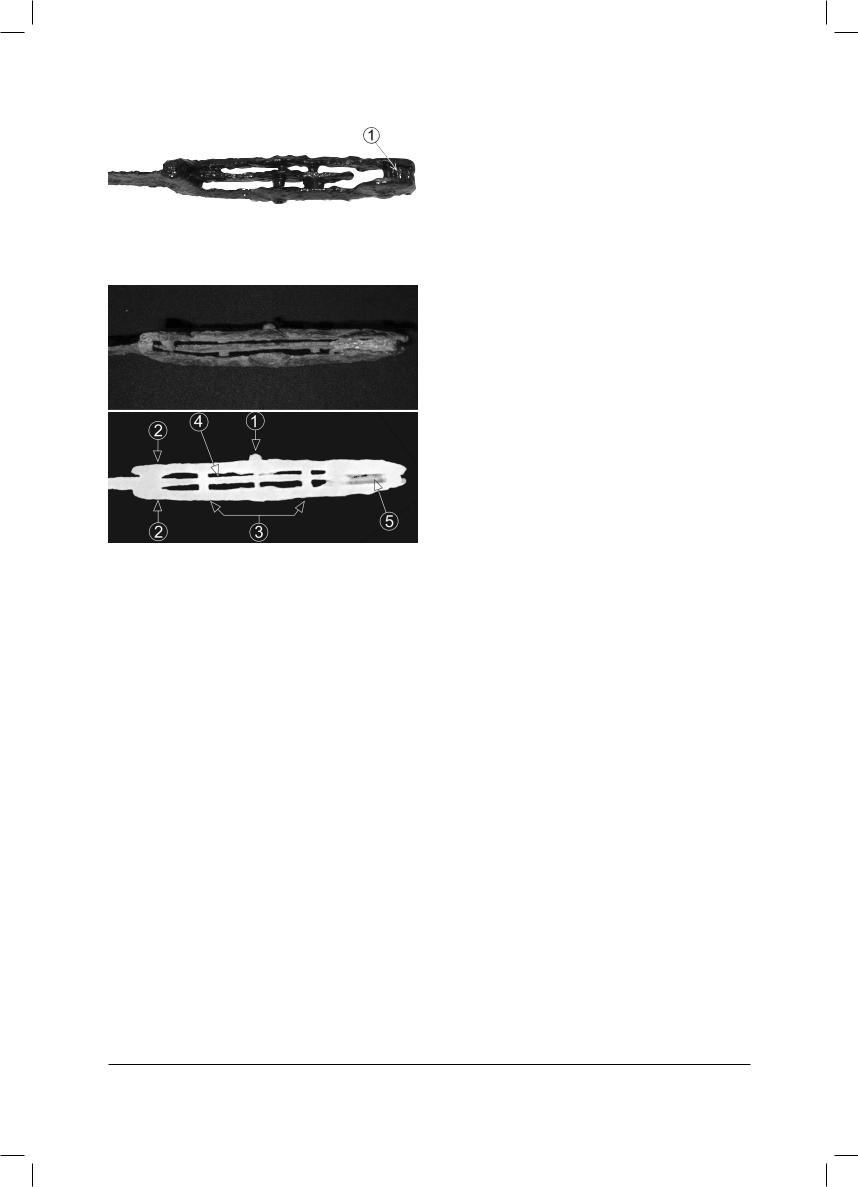
PUGIO - GLADIUS BREVIS EST
Fig. V/12: detail of hilt in composite technology. As well as showing quite clearly the various technological components, a metallic element on the pommel with the function of increasing its durability is indicated (point “1”), working together with the central rivet placed opposite. (photo by the author)
Fig. V/13: this hilt is shown in its natural state (top image) and under X-ray (lower image). In the natural one we can clearly see on the right the surviving part of the metal ribbon used to finish off the sides, which is one of the very few we have trace of. However, the rest of the technological elements are not so clear. They can, however be seen on the weapon under X-ray, in which we can easily identify:
1) passing rivet fixing hilt to blade. The upper part protrudes on the outside and acts as a decorative element;
2) external metallic plates;
3) internal rivets. Just like the rivet at point 1, they had the function of fixing the blade to the hilt, but in this case they are completely on the inside and not externally visible;
4) blade tang;
5) fragment of metal finishing edge on the side.
(photo and X-ray by the author)
adequate for this, so its practical function is limited to that of preventing the weapon from accidentally slipping out of the hand. There were almost always one or two rivets placed in it, which were quite often decorated on their visible side so as to embellish the weapon as a whole.
Fig. V/14: stylized drawing in blow-up of the construction components of a hilt made by “tight insertion” technology. (drawing by the author)
The grip22, whose cross section was midway between a circular and an irregular diamond shape, was not generally deeper than the closing pommel and the hand guard. Its most important characteristic, which we find in all known pugiones, is that it always has a central bulge in a more-or-less round and generally not too large shape. Its practical function is not essential and is probably only that of improving the grasp. It may be hypothesised that it was ratheradecorativeelement,relatedtotradition,ratherthan practical. We can now look at the construction technology ofthehiltwhiledulyrememberingtheabove-citedwarning that the lack of standardisation of ancient weapons very often makes it impossible to group them in rigid patterns, as it is always possible to find exemplars which are not possible to be placed exactly in the typologies that we are about to describe.
We can divide them into two main groups which,, we
will call “composite technology” and “tight insertion technology”:
Composite Technology:
this can certainly be considered the most distinctive technique for the construction of the pugiones, and again taken directly from the Celtiberian daggers. Together with the morphological characteristics of the various components used, it contributes decisively to making these weapons utterly impossible to mistake for another, and unique in their genre.
It was certainly an advanced construction method and not easy to carry out; and it was not appropriate for mass production;itrequiredtheratherlaboriousworkofaskilful artisan, where nothing could be overlooked. Precisely for
22 meaning the portion of the hilt between guard and pommel, hence that held by the hand.
52
Libro inglese BAR [A4].indd |
52 |
27/05/2012, 16.24 |
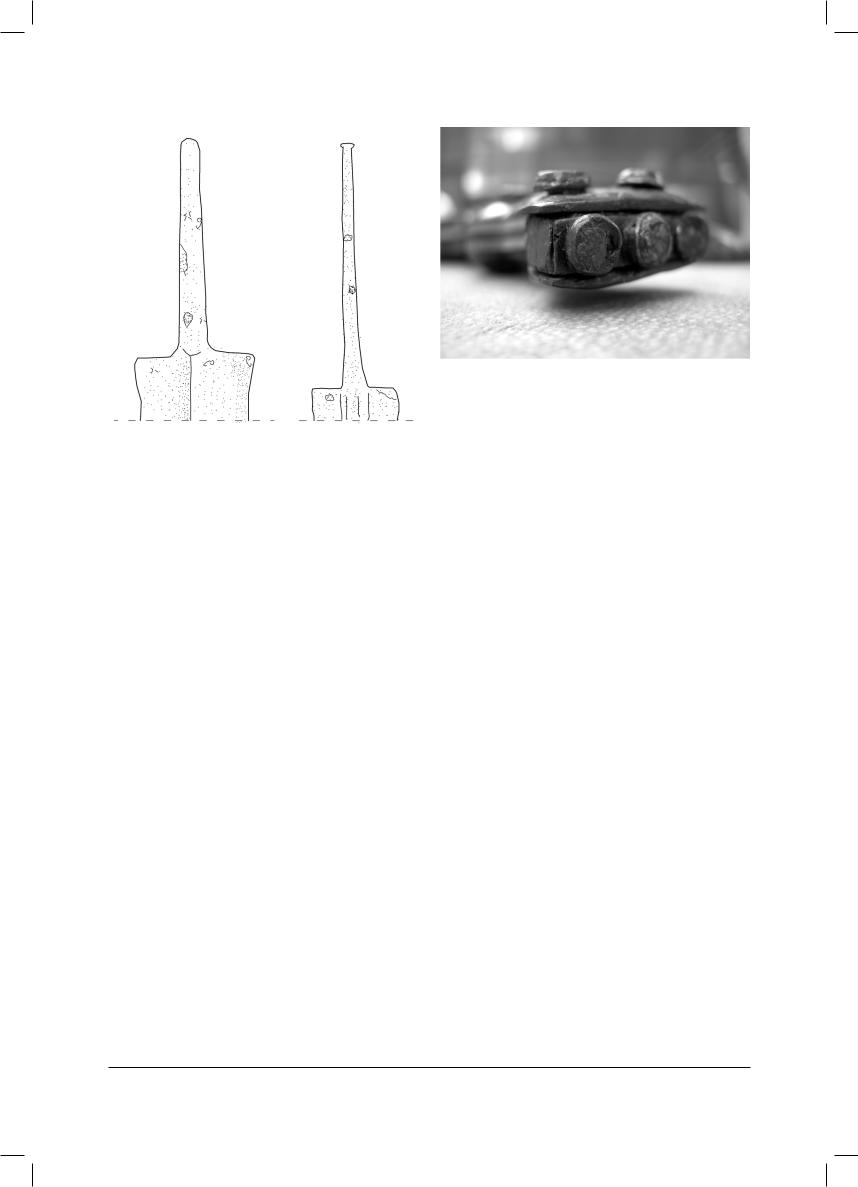
CHAPTER V - CONSTRUCTION TECHNOLOGY
Fig. V/15: examples of tangs of the “rod” type. They appear to be of very simple geometry, completely free of central enlargements or holes for the passage of rivets – absent also on the blade – and of beating on the top. (Drawing by the author).
this reason it bestowed a charm on the weapons which other construction methods could not achieve.
There are six main technological components which contribute to this technique:
-two internal plates of organic material,
-two metallic laminas, or external plates, covering the internal ones,
-a metallic ribbon for finishing the edges (when present),
-a series of metallic rivets.
From an examination of archaeological findings we know that the internal plates are almost always lost, which leads us to suppose with a good degree of certainty that they were often made of wood, which would be compatible with their function and their position. This material is economical and easy to work, easily adjustable to the blade tang and, therefore, able to ensure an excellent adherence to it. The contraindications are that it is not of anyvalueaestheticallyandsufferswearandtearfromlong contact with hands, however, being internal, in this case there is no problem. Some exemplars have, nevertheless, been found which show this component in bone, even if limited to Period II.
They were covered by external plates, still in iron, which were no more than very thin laminas, more or less decorated.
However, one should not make the mistake of considering these only a coating without any structural function; these actually made up the resilient part of the hilt, as they were sufficiently solid and well anchored onto the blade tang. On the other hand, it is possibly more correct to consider the internal plates as a secondary element as they had the sole function of filling the spaces left empty by the outer ones. The examination of some weapons which have lost both internal plates but have the external ones still in good condition and well attached to the tang, shows the hilt completely solid and perfectly suitable for a hypothetical use, without being at all affected by the lack of the internal components.
Fig. V/16: detail of a pommel in which we can clearly see the three rivets placed at the top. We guess that, other than being for decoration, they are necessary to fix the lateral finishing metal onto the grip. This exemplar was made by “composite” technology.
Some other occasional elements confirm this hypothesis; on some hilts, on a level with the upper pommel, whose external plates could easily undergo small bends due to its circular shape and the presence of a single central rivet (fig. V/12, point 1), some metallic elements have been noticed on the inside, whose function was to prevent this from happening; they were obviously created because the material on the inside was not considered to have any capacity for resistance.
To conclude, the external plates were certainly the most important part of the hilt. In contact with the hand and almost always made with great attention to detail, at times embellished in various ways, they were what gave it its ultimate appearance.
In order to summarise a description of the production process we can say that at first the two internal plates were made in the desired shape, and they were positioned in contact with the tang on both sides, and then they were attached with one or two metallic rivets. After this they were covered with the two external elements, which were placed on the two faces of the hilt, and at times the sides were finished off with a fine lamina of precious material suchassilverororichalcum.Intheexemplarsinwhichthis lamina is absent, we see that the internal plates are often in bone, a precious material and of pleasant appearance, which did not require any finishing. Some experts hypothesise that their external part, which is visible on the sides, was coloured with copper oxides23.
Everything was fixed together by means of a variable number of metal rivets, a maximum of 6, in various sizes, some concerning all of the described elements, others concerning only the internal ones. Finally, the outside was finishedoffwithdecorativeelementsofvaryingdegreesof value, insets and engravings.
In order to aid full understanding of the description above we included (fig. V/11) a diagram blow-up of this technology, from which the position of the various elements and the relationship between them is clear.
Thefinelaminacoveringforthelateraledge(elementno.4 in fig. V/11) has rarely survived, most likely due to the ease with which it could become separated from the rest.
FiguresV/12andV/13showsomeexemplarsbuiltwiththe technique, where the double-laminated structure is quite visible. We can see in no. V/11 all the main technological elements, except for the internal plates which have
23 Herbert Westphal, “Ein römischer Prunkdolch aus Haltern”;
53
Libro inglese BAR [A4].indd |
53 |
27/05/2012, 16.24 |
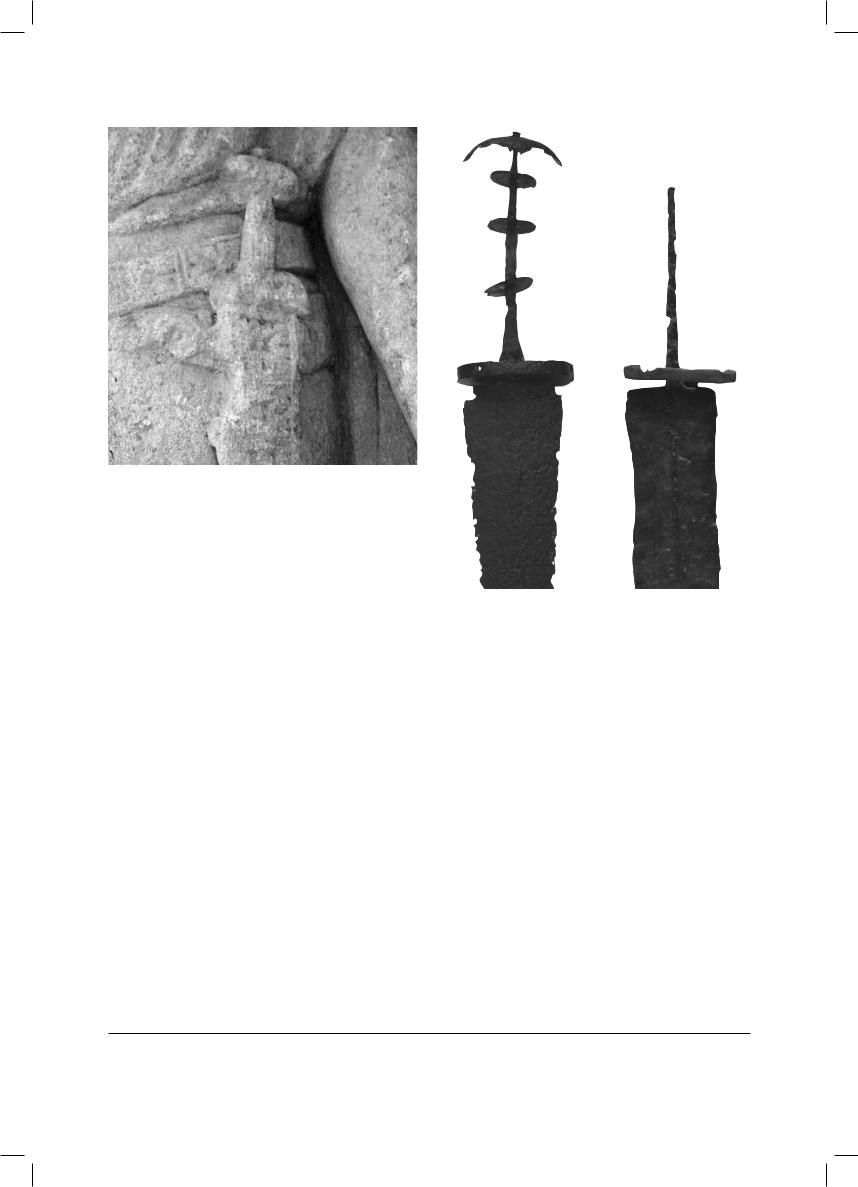
PUGIO - GLADIUS BREVIS EST
Fig. V/17: detail of the pugio on the stele of Firmus (Rheinisches Landesmuseum, Bonn, Germany)
been lost, including, however, a metallic element for reinforcementofthepommel,whichwementionedearlier. The hilt in fig. V/13 is also very interesting, and after a skilful cleaning of all the impurities, revealed a discrete portion of lamina finishing on the edge. This is one of the very rare exemplars in which this element can be seen.
b) Hilt with “tight insertion” technology
As previously seen, towards mid I century A.D. we experience a new technology for the assembly of the hilt, which is easier to complete in comparison with the previous one and which, due to its characteristics, we will call “tight insertion”. This period coincides with the appearance of the gladius known as “pompei”24 and this may not be by chance. In comparison with previous models (known as “hispaniensis”), the manufacturing of this one was decidedly simpler, with parallel cutting edges, a short and triangular point, and it was much more standardised25. Also the metallurgy used was of a lower level, and the blades are often forged without the stratification of different types of steel26. This leads one to believe that there was the necessity to satisfy a request for more weapons than previously and, therefore, to adopt
Fig. V/18: pugio from the museum of Saalburg (Ge) (on the right) in comparison with a gladius from the end of the Republic. Both have a hilt with an identical bronze plate, which leads to suppose that they underwent a very similar construction technique. (photo by the author).
a simpler technology, even if the quality was lower. The method must have been successful because both the pugiones and the gladi match its logic. The former were built with simple “tight insertion” technology, whereas the “pompei” gladi completely replaced the previous27, more elaborate ones.
Thetechnologicalcomponentsusedaregenerallythesame as the ones we have already seen with the difference that the hilt is not held onto the blade by screws like in the previous ones, but rather by simply inserting the blade tang into it without using any rivets; and this is very similar to the technique used to build gladi.
Inthiscasethebladehasatanginaveryregularshape,like
Fig. V/18: specimen preserving the pommel of closure. It represents one of the few clues of “tight insertion-subtype “A” technology in its secondary version (drawing by the author, private collection);
24R. D’Amato e G. Sumner, “arms andArmour of the imperial roman soldier”, Ed. Frontline Book; M.C. Bishop & J.C.N. Coulston, op. cit.;
25Michel Feugere, op. cit.;
26M.C. Bishop & J.C.N. Coulston, op. cit.;
27Michel Feugere, op. cit.;
54
Libro inglese BAR [A4].indd |
54 |
27/05/2012, 16.24 |
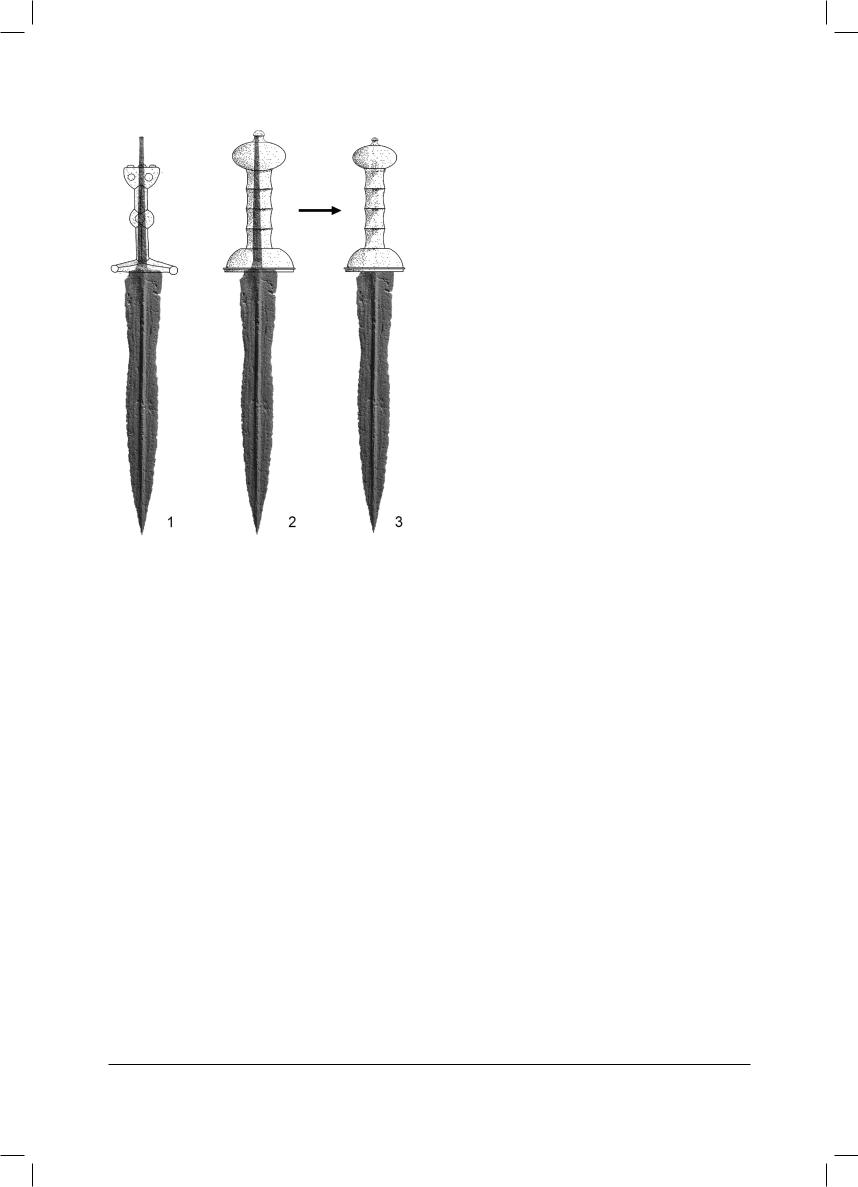
CHAPTER V - CONSTRUCTION TECHNOLOGY
Fig. V/19: Virtual hilt reconstruction tests with “tight insertion subtype A” technology. In position 1 an original hilt (museum of Haltern) is superimposed on a pugio blade, which appears absolutely incompatible; in position 2, instead, a classic gladius hilt is superimposed, which appears to fit perfectly, but is only a little too large as it originally belonged to a much bigger weapon. Once it has been slightly re-proportioned (position 3) we can now see the probable and unexpected image of many pugio exemplars
a simple bolt with a section tending towards a rectangular shape (element of the “rod” type in fig. V/9) which lends itself better to this purpose than a wide, flat one. It is still without the central bulge, which would obviously have prevented its insertion; nor are the holes for the passage of rivets present, except in very rare exceptions.
The manufacturing process which was used to create the pugiones with this technique is less certain than the “composite” one, because a large quantity of blades with compatible blades have been found, but very few exemplars have been found together with their hilts, not even partial ones, thus depriving the expert from deepening his knowledge of this technique. Similarly, this is attributed to the ease with which the components separated from each other, and becoming irreparably lost, due to the lack of rivets to make it secure.
For this reason the following description, even if sufficiently reliable as it is based on common techniques also used for other weapons form various cultures and ages, is more approximate than the previous one.
Once the blade with its “rod” tang and hilt in the desired shape in hard wood had been separately made, the metal was brought to red heat and then driven with force into the special cavity, the size of which was slightly inferior to that of the tang. This forceful insertion, together with the elevated temperature of the metal, created a sufficiently secure bond between the two elements, at least for the purpose they were assigned for. Then the external, metal
Fig. V/20: hilt with tight insertion subtype “B” technology in ivory, preserved in the Museum of London. From the left: view of main side, lateral side, back side. At the bottom: view of the bottom. (drawing by the author from information taken from “Zu einer elfenbeinernen Dolchgriffplatte aus Nida Hdderneheim am Main” by Jurgen Obmann)
plates were applied, which were substantially similar to those seen previously, working them with a hammer to make them adhere perfectly to the part beneath. Finally, there was no lack of decorative work applied to the weapon.
In the exemplars of type II one sometimes notices a rather curiouscomponentfromatechnologicalpointofview:some rivets placed on the upper edge of the pommel, in a number of never more than three.They do not belong exclusively to thetypeoftechnologyweareexaminingatthemoment,but are common also to the “composite” one. In any case, their function is not well defined, also if they certainly did not have a role of great importance from a technological point of view. In some cases they do no more than keep the top part of the lateral finishing material of the pommel in place, but often they are only to be considered decorative28.
As said before, it is easily understood that this technique is decidedly simpler than the first and suitable for mass production, without this necessarily being at the expense of quality. Exemplars of exquisite craftsmanship are, in fact, not at all rare; on the contrary they are actually more numerous than in the first periods.
It is now necessary to examine two techniques which, thanks to their characteristics, can be considered variants ofthe“tightinsertion”type,andsowewillcallthem“tight insertion of subtypeA” and tight insertion of subtype B”.
Tight Insertion subtype “A” technology:
The first type we are going to examine is very interesting and in some ways surprising as it is from this particular type of technology that weapons are derived which are of very different appearance to the more conventional ones looked at up until now. Let us therefore try to examine them carefully.
28 Carmelo Fernandez Ibanez, op. cit.;
55
Libro inglese BAR [A4].indd |
55 |
27/05/2012, 16.24 |

PUGIO - GLADIUS BREVIS EST
The first most important indication of its existence is on the stele of “Firmus”.
Theexceptionaldefinitionofdetailallowsustoseethatthe hilt of the pugio of this soldier is not like any we have seen until now, but totally similar to that of a gladius. Hence, the typical guard tending towards a semicircular shape is evident, as is the superior pommel with the small – but extremely typical – pommel of closure above, not similar in any way to the more standard ones seen till now.
In any case, this one piece of data alone may not be sufficient to classify it as a distinct subtype if there were not numerous other archaeological findings to confirm this.
Some come from the legionary camp of Vindonissa. As we know, on this site of great scientific value exceptional circumstances came to be which allowed findings in organic materials to survive in excellent condition, and among these is a wooden grip of similar craftsmanship to a gladius, but substantially smaller. Its size, not so much in length but rather in width, and above all the diameter of the internal opening which held the tang, makes it incompatible with a gladius but at the same time perfect for a smaller and lighter pugio.
Furthermore, from the same place we have an exemplar (chap. IX – database, no. 30) which has both its guard and grip still intact, both of which are similar to those of a gladius. The pommel is unfortunately missing.
What is more, also in the museum of Saalburg (GE) an exemplar is kept (fig. V/18; chap. IX – data base, no. 93) on which we can see that the part of the guard has been well preserved, made with a metal plate. What makes it unique is that it is perfectly identical to a type frequently used for some gladi. It would not seem to be too audacious to suppose that the whole hilt and its relative construction technology were very similar.
In addition to these exemplars, which are very indicative in themselves if nonetheless limited, we can easily extend our consideration to comprehend many other well-known ones. These are completely deprived of all parts of the hilt and could pass unobserved, if it were not for the fact that with closer observation we can see that they have a beaten tang at the top. This detail derives precisely from the constructive methoddescribedaboveandis,furthermoreinantithesiswith both the “composite” technology – which we have seen is based on a flat tang – and the “tight insertion” technology in its main version where the upper beating would have completely prevented insertion of the hilt.As it is impossible toignorethegreatnumberofthesetangs,wemustdeducethat thistechnologywasnotasrareasonemightthink,butsimply less evident to the eyes of the expert. A simple explanation forthiscouldbethat,incomparisonwithhiltsmadeusingthe main forms of technology, these hilts very often had to be in organicmaterialandthereforehardlyeversurvived.
From a technological point of view, the experience of experimental archaeology teaches us that assembly was rather simple in the end and consisted in introducing three main elements in a precise order onto the tang – clearly onto the “pointed” type -: first the guard, then the grip and finally the superior pommel.
In order to guarantee the firm fixture of all these elements, once the first two had been inserted the top of the tang was beaten until an enlargement similar to the head of a nail was made which prevented them from coming out. Lastly,
the pommel was applied by glue if it was made of wood. If the pommel was made of metal, as is frequent in gladi, instead of proceeding to beat the tang, the pommel was heated until red and then thrust inside the top of the tang. Once it had cooled and hence shrunk in size, it created a solid fusion.
To conclude, we have considered it useful to perform a “virtual test”, which is possibly not very scientific but certainly more illuminating. It has the double objective of testing what has been stated above and helping the reader to imagine what such a weapon would look like.
Therefore, we took a blade which had a beaten tang at the top and we attempted to add two real hilts in a virtual manner: one is from a pugio kept in the LWL Romermuseum (Haltern) and the other of a gladius from a private collection, obviously scrupulously respecting the original size (fig. V/19).
The result, even if only speculative, speaks for itself.
Whereas the hilt from the pugio is completely incompatible with the tang (fig. V/19, pos. 1), that of the gladius fits perfectly (fig. V/19, pos. 2) (apart from a small fold towards the left due to the tang being slightly damaged). It is, therefore, evident that once the sizes have been perfected in order to adapt them better to a pugio blade, being shorter and narrower than that of a gladius, it appears to be completely compatible (fig/19, pos. 3).
Therefore, it has finally been possible to demonstrate what a weapon assembled with this type of technology may often have looked like, which was, as already stated, substantially different from common imagination.
Tight Insertion subtype “B” technology:
We deduce its existence and its characteristics only from two very similar hilts in ivory: one is preserved in the Museum of London29, and the other comes from NidaHeddernheim (Germany)30. The similarity is, however, so evident to make one think of a common fabrication technique, which is simpler in comparison with the main variant. Both seem to be made from a sole piece of ivory, duly shaped according to the classical shape of hilts of pugiones from Period II, and inside which we can see the special cavity for the insertion of the tang of the blade.
The special characteristic is that one of the two surfaces is completely finished off, whereas the other - flat and uncarved and most likely the back - has a place for what must have been a metallic lamina31. Neither of the two have preserved their guard, which could have been made in the same material, obviously metal, bone or wood.
It is easy to understand that it was simply necessary to insert this hilt, made almost from a single piece, onto the blade tang in order to finish off the weapon.
There are no other findings of this subtype of hilt, but this does not mean that they were very rare, as it is simply possible that these are the only surviving ones because they are made of non-biodegradable material, whereas the all the others in bone or wood have become irreparably lost.
29Archives: PDC/ER 546
30Jürgen Obmann, “Zu einer elfenbeinernen Dolchgriffplatte aus Nida Hedderneheim am Main”, J.R.M.E.S. 3,1992
31Jürgen Obmann, op. cit.
56
Libro inglese BAR [A4].indd |
56 |
27/05/2012, 16.24 |

CHAPTER VI
SHEATHS
Sheaths have always been an essential part of ancient cutting weapons. Their main purpose was that of assuring easy and safe transport of the weapon while hanging from the soldier’s body. Despite this, in the I century A.D. we experience the appearance of exemplars which are particularly rich in decorative components and the valuable materials used to create them. We do not believe that these were only for aesthetic purposes, as has been held until today, but that their purpose was above all for political propaganda and apotropaic.
We, therefore, believe that it is right to begin our study from this point – doubtlessly the most eye-catching – that is to say the decorations and their related symbology, then wewillgoontotacklemoretechnicalsubjects,suchasthe suspension systems and construction techniques used, and finally the chronological evolution.
Decorations: Evolution and Symbology
Decorations on sheaths are exclusively found on the pugiones of type II. Their intrinsic symbology, and the implications this suggests, is one of the most surprising aspects of the weapon we are analysing.
During the Republican period, from the beginning of the use of pugiones in the Romans panoply, the sheaths were characterised by maximum simplicity and were basically without any form of decoration, limited to being a simple support instrument to contain the weapon. Very few such ancient exemplars have survived, and all that is left of them is a simple metal frame, onto which a covering structure in organic material (wood, leather) was most probably placed for its completion. Some rare exemplars of Celtiberian origin are a little more elaborate with a certain amount of carved decorations covering the surface, butitisnotcertainwhethertheseexemplarsareofRomans manufacture.
However, with the end of the Republic and the beginning of the Principate a very strange phenomenon occurs; the extreme simplicity suddenly stops and is replaced by a complete change in direction, that is the sheaths begin to be richly decorated in various symbols and ornaments. The phenomenon is very evident, so much so as to bestow them withthevalueofexcellentcraftsmanshipifnotastrueworks of art, generating a sudden, polychrome and astounding explosion of decorations in enamel and precious metals. It must be remembered that the phenomenon concerns almost all exemplars, with very few exceptions (among which we recall two: one coming from Xanten and the other from Mainz, no. F32 and F34 Chap. IX).
This transformation is too radical to have been merely due to chance; and during a careful study we have noticed that the appearance of these precious sheaths is connected to multiple factors, such as: the fashion at the time, the
divinisationoftheEmperor,politicalpropaganda,andalso a apotropaic function.
In the Augustan Period glitz was widespread, as was a new artistic style affected by the so-called “neoatticism”.1 As R. Bianchi Bandinelli describes: “the Augustan art reaches its highest and most typical production … in the craftsmanship of precious materials, destined to a public from the high ranks of society … It is truly the art of silver, inlaid gems, of glass treated like cameos … What Augustan artproducedinthisfieldremainedanexampleforthewhole duration of the Romans Empire.”2 The great splendour of the costumes at the Imperial court, and in general in the upper levels of society, is admirably described by Tacitus in various passages in one of his greatest works3, allowing himself to describe how the social climate of the austere Republic was now very far away: “….and the richness of the banquets, maintained with enormous expenditure for one hundred years from the end of the Actium battle until the feats of arms which brought Galba to power (31 B.C. – 69 A.D. n.d.a.), fell slowly into disuse ….. Whoever was more splendid due to the availability of his means, his sumptuous home and riches, the more distinguished his name and clientele was.”4
“forCorbulo(theactiontookplaceduringtherekindlingof the hostilities against the Sides for the control ofArmenia in 58 A.D. A.N.) it was more arduous to fight against the sloth of the soldiers than against the perfidiousness of the enemy … there were veterans who had never been on guard duty … without helmets or armour, with their only care to be elegant and make money.”5
This running after splendour probably reached its height under Caligula – even if Claudius and Nero were no less
– who squandered in one year of his reign 27,000,000 aurei (Romans gold coins), saved by Tiberius during his 20-year reign.6
AgreatchangesetinwhenAugustustookpower,anditwas represented by the Hellenistic cult of the Sovereign which was reserved only for the imperial house and no longer widespread among commanders or powerful Romanss as in the Republican Period. Veneration of the Emperor was the demonstration of loyalty towards Rome and its first Representative, whose presence was strengthened by the spread of his “Imago” and by symbols referring to him. The portrait of the Emperor and symbols connected to him were present on coins, statues and busts (widespread from the taverns to the forums of the cities in the far Provinces) just as one could find individual “miles” on banners and weapons. The Imago of the Emperor was sacred because his imperial majesty (maiestatis) and his divine power (numen)actedthroughit.AsAthanasius7 relates,“whoever then adores the portrait, adores the Emperor in it. The portrait is, in fact, his image and essence.” Whoever treated the images of a divinised emperor without respect, whoever removed or damaged the Imago of the emperor, could have been accused of high treason.8
ThedivinisationoftheEmperorfavouredthedevelopment of imperial propaganda which frequently coincided both in purpose and form. It profoundly involved everything in Romans society from that period: from monetary themes to those of arms and military equipment;9 from literary to monumental art forms10; because everything in all
1 |
The classicist cultural trend widespread in the ancient greek world, highly influencing the young boys of the Romans jet set; |
2 |
Ranuccio Bianchi Bandinelli, “Roma, l’arte nel centro del potere”, Ed. Rizzoli; |
3 |
Annales; |
4 |
Lib. III, 55; |
5 |
lib. III, 35; |
6 |
Richard Holland, “Nerone”, ed. Carocci. |
7 |
Atanasio,Apologia contro gliAriani, 3, 5, 5 |
8 |
Eckhard Meyer-Zwiffelhoffer, Storia delle province Romanse. Ed. Il Mulino, Universale Paperbacks. |
9 |
Michel Feugere,” Weapons of the Romanss”, ed. Tempus pag. 203. |
10 |
Paola Chini, “Vita e costumi dei Romansi antichi”, n°9, “La religione”, ed. Quasar, 1990. |
57
Libro inglese BAR [A4].indd |
57 |
27/05/2012, 16.24 |

PUGIO - GLADIUS BREVIS EST
the world had to emanate the power of Rome and of the Emperor, and any means was valid to make him known and render him honour.
It is possible to observe this evolutionary phenomenon in the development of monetary and propagandist themes which became more marked with the advent of Julius Caesar as a consequence of the intensification and provocation of political and armed conflicts11. But it is with Augustus that the Imperial cult really began to spread through political, cultural and religious propaganda which aimed to gain universal approval for Rome and the Emperor. More precisely, it was a phenomenon of social cohesion for all the citizens of The Empire as well as being a means of checking on all the local leaders, since the Imperial cult they sustained was the way they demonstrated their own approval of both Emperor and Empire. On monetary themes the subject was no longer the gens12, or the political party, but living individuals who wereinchargeoftheirdestiny.Theabsolutepredominance of one person over all the Romans state, in fact, made it possible to exalt the propagandistic function to excess. Even the cult of the Capitoline Triad was more and more frequently substituted by the new cult of the state, incarnated in the figure of The Emperor.
All this seems to have made a clear reflection on the weapons – not only the pugiones but also on the helmets and on the gladi – which we now see all rich in decor, aesthetically very eye-catching and carefully made, but consequently also very expensive. Just to have an idea, consider the difference between helmets from the Caesarian age (like the ‘Mannheim’ type) and those from only a few decades later (the “imperial Gallic/Italic type). Whereas the former were very simple in shape and decoration, little more than a metal cap, the latter ones often have every imaginable type of decoration, such as silver ribbons, pietre dure etc.
The sheaths of cutting weapons make no exception and during this period they are made in an abundance of precious materials with images from mythology, imperial propaganda and symbols; which only goes to confirm that the decorative images are not just there for their own sake, but they have a secondary purpose.
This observation leads us to believe that the value and purpose of these decorations was probably one and the same, even if the figurative message was represented in a different manner due to the different dimensions of the weapons.
The reason for the choice of symbols as a preferential means for imperial propaganda is admirably explained by René Guénon: “While the organisation of language is analytical, conversational like human reasoning itself, symbolism is essentially concise and, therefore, intuitive. Its conciseness is what makes the symbol open to absolutely limitless possibilities of conception and, in its plasticity, makes it superior to language, which is, instead, characterised, by more definite and fixed meanings.”13
If we observe the themes on the Imperial coins, we find numerous images related to the classical divinity of the Romans Pantheon (Jupiter, Apollo, Hercules, Mars, etc.) or from the provinces (such as Serapis, sol invictus, Isis, Heliogabalus, etc.) or finally to allegories of abstract entity such as the figures of Genius, Victory, the goddess
of Rome, Happiness etc. everything always in connection with the Imperial figure.
The deification of Augustus and his successors also acquired the characteristic of conforming their likeness to a divinity, for example Nero to Apollo, Commodus to Hercules, Heliogabalus to the Sun.
Even Augustus himself, according to legend, was a direct descendant of a divinity as he had been conceived in a relationship between his mother and Apollo during a ritual of sacred prostitution14, as Cassius Dio relates: “Atia (Augustus’ mother A.N.) claims with absolute certainty that she conceived him with Apollo, because, having once fallen asleep in the temple of this god, it had seemed to her as if she had had intercourse with a dragon, and at the right moment she had born a child. Before the child was born, Atia dreamt that her entrails were carried to the sky and they were spread all over the earth; that same night Octavius (father of Octavian, A.N.) dreamt that from his wife’s womb the sun was born.”15
After the death ofAugustus, problems arose regarding his successor, and this political phenomenon was reflected on the iconographic layout, where images of politicians began to appear next to the symbolic figures.
Two well-known gladi demonstrating this are the Gladiusblech of Bonn (where a young woman, probably Julia, wife of Agrippa, is pictured between her sons Gaius and Lucius Caesar, adopted by Augustus and, therefore, the main heirs to the throne) and the so-called sword of Tiberius (where it is believed that the figures of Germanicus, Tiberius andAugustus are pictured).
Among the well-known pugiones only one, which originated from an imprecise locality in the north of France and is now preserved in the museum of Mainz (Germany), pictures the effigy of an unidentifiable figure (Chapter 9, exemplar 215).
The apotropaic element (from the Greek αποτρέπειν apotrépein=”to keep away”) can be found in many figures present on the sheaths of pugiones, as well as gladi; and the significance of this is to be looked for in the weakness and superstition of man, above-all ancient man. The miles had to face death at every war conflict, exorcising it with rites and apotropaic gestures, which psychologically worked as a flight mechanism, keeping the danger away and, therefore, also the fear which it generated.
In this way we have introduced the fundamental concept that the decorations were not to be taken at face value, but that they had a definite symbolism; and this hypothesis finds confirmation in the writings of Edit B. Thomas16. Re-proposing also what Gonzembach says, he states
– unfortunately dedicating only a brief mention to the subject – that the decorations should be understood as propaganda and that they were symbolic of belonging to a specific legion. Unfortunately, modern understanding of an ancient symbol is not always simple because a modern meaning might not correspond with what would normally have been associated with it at the time of its creation. Consequently, it follows that a specific image may be inappropriately deciphered even within a correct symbolic-mythological explication. For this reason a careful evaluation of the manuscript “Notitia Dignitatum” 17 has been made, which, despite being a later document,
11Roberto Bartolini, “Monete di Roma Imperiale”, ed. Mondadori .
12Paola Chini, “Vita e costumi dei Romansi antichi”, n°9, “La religione”, ed. Quasar, 1990.
13René Guénon, “I simboli”.
14Giuseppe Fazzini, “Vespasiano”.
15Cassio Dione, “Storia Romansa”, Libro XLV, paragrafo 2-3. Ed. BUR
16Edit B. Thomas, “Helme, schield, dolche, Akademiai Kiado, Budapest.
17The “Notitia Dignitatum” is an historical document of the late Empire, perhaps a kind of yearbook, written during Theodosius’reign, but updated at least until 425-429A.D.
58
Libro inglese BAR [A4].indd |
58 |
27/05/2012, 16.24 |
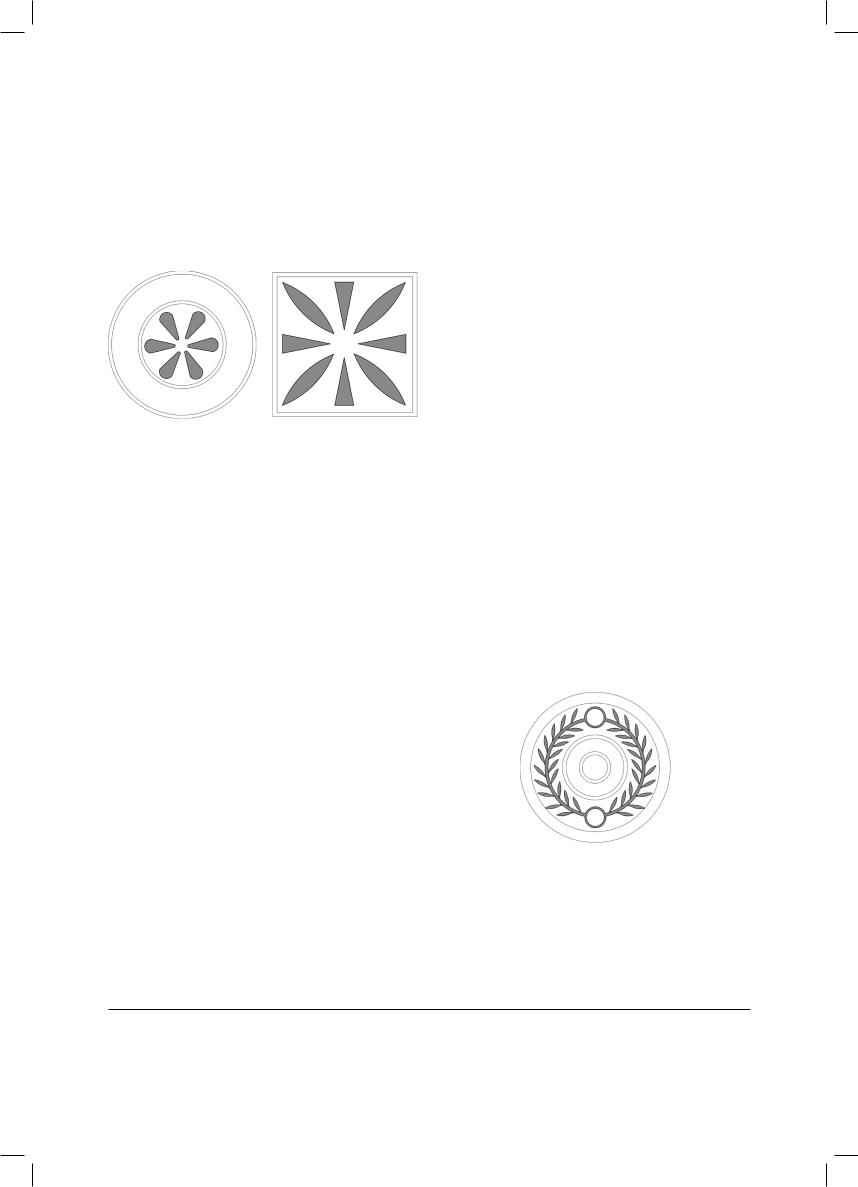
CHAPTER VI - SHEATHS
has a collection of images and symbols of military and civil officials whose full meaning nowadays is in many cases unknown. It is important to find corresponding, similar images both in this document and on the sheaths of the pugiones: if in the former they have a precise symbolic meaning, by deduction they must have the same in the latter.
SUN (Latin SOL) inside geometrical figures
Many religions, above all ancient ones, associate the sun with an idea of divinity because everything in nature depends on and is regulated by it18. This religious cult, which was also followed by the Latin civilisation, was introduced by the first Sabine king, Titus Tatius19.
The Sun is the origin and the centre, and from which everything emanated. With this concept in mind the sun has been universally represented as a point inside a circle. In the Notitia Dignitatum numerous symbols are pictured which experts are led to believe are sun types20, and the figurative analogy with those pictured on the sheaths of the pugiones, leads us to believe that they are connected to the Sun too.
Frequently the Sun is inside a square. The square is considered a symbol of the earth and this could suggest that the Sun dominates over all the earth. However, as Rome could be symbolised by a square (see symbol “square”), we could also understand it to mean that Rome impersonates the Sun.
Whereas in the Notitia Dignitatum a single Sun is depicted per shield, with different colours, shape and number of rays for each representation, in the pugiones there may be one or more Suns per sheath, with different characteristics for each one.This fact means that we can exclude the idea, at least for the pugiones, that a representation of a Sun could be the distinctive sign for a legion or an auxiliary troop, partly contradicting what Edit. B. Thomas (op.cit) stated.
On examining the symbolic meaning, for Panciroli21 a central circle enclosed within a larger circle has the meaning that it is a single Imperium which holds together the “Orbe Romansus”, whereas the rays surrounding the circle indicate that the latter is protected from the violence of enemies. In the Notitia Dignitatum we find suns with 3- 4-6-7-8-9-10-11-12-13-14-16-18-20 rays, in the pugiones the Suns are represented with 4-6-8-12-16-20 rays.
Sometimes the number of rays is totally casual, whereas at other times their number acquires a symbolic value. For example, the Sun with 7 rays is connected to the Mithraic religion, where there are seven metal-planets, and the
crown with 7 rays is typical of the initiation of the initiate. On the other hand 12 rays can be referred to the 12 months of the year and to the zodiacal months.
In Romans tradition, there were twelve vultures dictating the good omen to Romulus, twelve greater gods, and twelve rods made up the fasces.
Also the colour and the shape of the rays can have a meaning. For P. Berger in “The Insignia” the beams represent lances or arrows, whereas for G. Panciroli (op. cit.) they represent valid defence against the enemy opposed by the centre, made up of Imperial units. When theraysformatypeofdiamond–averyancientsymbolof divinelightning–theyacquirethemeaningof“deathfrom the sky” by means of “lightning projectiles” on behalf of thedivineEmpire.OntheemblemoftheBalistarii juniors, the Sun surrounded by rays, represented by red and blue diamonds, alludes to the sharp points of the projectiles which have been cast.
In modern times, some experts have defined the drawings we have described as Suns as “rosettes”. It is necessary, however, to observe that in Romans times only the wild rose existed. Its name was given by Pliny The Elder, who claimed that a Romans soldier was healed from rabies by a decoction made with its roots. It is the ancestor of the modern rose, whose large petals, which total 5, do not correspond numerically to the representations we have examined.
In any case, the rose was the symbol of the legio V Macedonica Legion, whose value was certainly not a florally Romanstic one, but certainly that of the sun. In actualfact,manyfloralpatternshavebeenconnectedtothe sun since the Paleolithic Age, and the wheels grasped by the Celtic solar divinities often assume the shape of a rose. In the Romans-Celtic world the rose is often associated with solar symbols and even with Jupiter’s eagle, whereas the relationship of the rose with death is typical of the Romans world, symbolising eternal spring22.
LAUREL(Latin. LAURUS)
Ovid tells us in Metamorphosis how the nymph Dafne, in order to escape the insistent amorous approaches of Apollo, asked her father, the river god Peneus, for help, who then transformed her into a laurel plant23. Apollo, clasping her in his arms exclaimed: “As you cannot be my spouse, well then you will be my tree. My foliage, my cither, my quiver will always be entwined with you, oh laurel,” thus becoming a sacred symbol for Apollo, and consequently, as divine protector of art, the prize for poets
18from “I Simboli”, Le Garzantine. Ed. Garzanti.
19from “Mitologia - I miti greco-Romansi raccontati da Pierre Grimal”, ed. Garzanti.
20Beniamino M. Di Dario, “La Notitia Dignitatum, immagini e simboli del Tardo Impero Romanso”, edizioneAr.
21In “Commentarium”;
22J. M. C. Toynbee, “Morti e sepoltura nel mondo Romanso”;
23in “Metamorfosi”, I,450-567; X,92;
59
Libro inglese BAR [A4].indd |
59 |
27/05/2012, 16.24 |
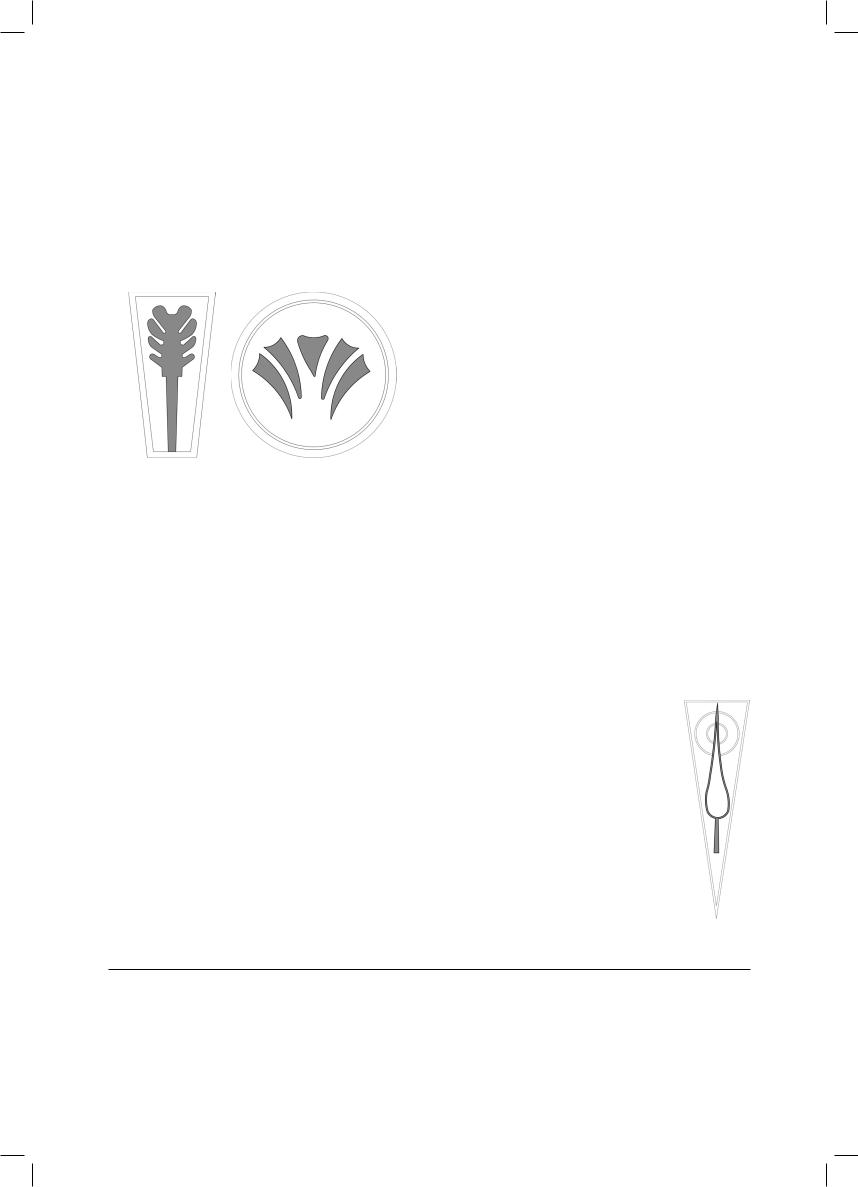
PUGIO - GLADIUS BREVIS EST
as well as being used in prophetic rituals24. Laurel,beingan evergreen, furthermore represented immortality acquired by meansofvictory,theemblemforbothwarandspiritualglory, the distinction for victorious generals after a triumph25. The victory weapons were bound with sprays of laurel and laid beforetheeffigiesofJupiter,astheyhadapurifyingfunction forspiltblood.Infact,theplantwasalsoattributedtoJupiter, and according to legend, among all those planted by man, it wastheonlyonenevertohavebeenstruckbylightning.26
THE PALM TREE
This plant is symbolically connected to Apollo because this god was born on the sterile island of Delos at the foot of a palm tree, the only tree present on the whole island.27
Ovid narrates that Rhea Silvia, before giving birth, saw Romulus and Remus in a dream in the shape of a palm tree, which was participating in the glory of Apollo, the Eternal Sun: “Two palm trees were erect with a prodigious appearance, and one was higher than the other. The whole world was covered by its magnificent branches, and it touched the furthest stars with its foliage”28
Thepalmtreeisauniversalsymbolofvictory,regeneration and immortality29, and for this reason it was offered to the winners and carried in moments of triumph. Due to the shape of its leaves, which are similar to rays, and their layout, it has always been associated with the myth of the sun from the earliest of times. It is also associated with the origins of Rome.
THE TEMPLE
The temple (from the Greek temenos) is the sacred area, which is separated from the profane world by means of walls30. The temple is a reflection of the divine world and its architecture bears witness to the image that men have of the divine31.
The symbolic reference found on the sheaths of pugiones could be connected to imperial propaganda initiated by Augustus in order to highlight the fact that the Emperor and all his works were guided and protected by the god Apollo. The representation could, therefore, be that of a temple erected in Anzio to give thanks to the god Apollo, as this god guided the victory ofAugustus against Sextus Pompeius and Anthony; or the temple of Apollo Palatinus where the collection of oracles, called the “Sibylline Books,” was kept because the Cumaean oracle pre-announced the birth of Augustus, the pacatororbis, according toApollo’s wishes.
Another connection is that with the temple of Jupiter FeretriusontheCapitolium,aplaceofcult,wheretrophies of those who had killed an enemy king or commander in single combat were deposited (the building was restored by Augustus, and at various times during the Empire many sovereigns re-proposed the same propagandistic iconography).
THE CYPRESS TREE
Bothbecauseofitslongevityandduetothe fact that it is an evergreen, this is a sacred tree for many peoples. For the Greeks and the Romanss it was a tree connected to the cult of the dead, and even nowadays we often find it adorning cemeteries32.
It was the symbol of various divinities: Cronus (Saturn), Hesculapius, Apollo due to the flame shape of its foliage; and of many female divinities, such as: Cybelus, Persephone, Aphroditis, Artemis, Eurynome, Hera andAthena33.
24Lucia Impelluso, “Dizionari dell’Arte – La natura ed i suoi simboli”, ed. Electa.
25J. Chevalier eA. Gheerbrant, “Dizionario dei Simboli – miti, sogni, costumi, gesti, forme, figure, colori, numeri”, ed. BUR Rizzoli.
26“I Simboli”, Le Garzantine. Ed. Garzanti.
27Da “Mitologia - I miti greco-Romansi raccontati da Pierre Grimal”,ed. Garzanti.
28A. Cattabiani & M.C. Fuentes, “Bestiario di Roma”, ed. Newton Compton.
29J. Chevalier &A. Gheerbrant, “Dizionario dei Simboli – miti, sogni, costumi, gesti, forme, figure, colori, numeri”,ed. BUR Rizzoli.
30“I Simboli”, Le Garzantine. Ed. Garzanti.
31J. Chevalier &A. Gheerbrant, op. cit.
32“J. Chevalier eA. Gheerbrant, op. cit.
33“I Simboli”, Le Garzatine, ed. Garzanti.
60
Libro inglese BAR [A4].indd |
60 |
27/05/2012, 16.24 |
